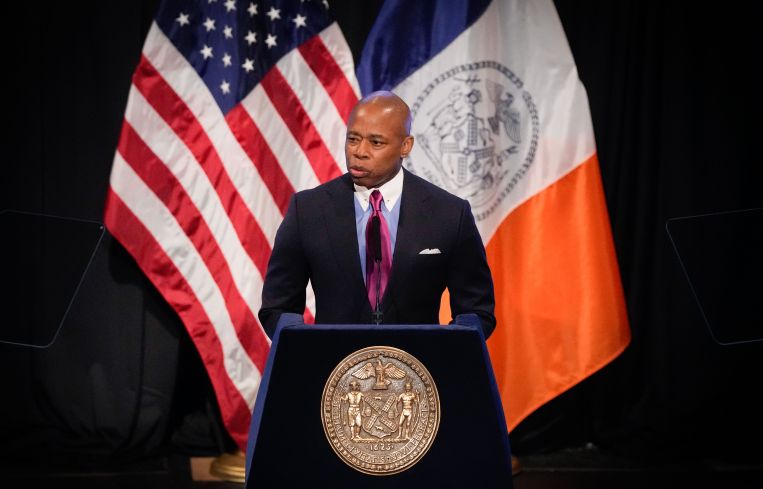Adams Aims to Rezone Midtown for More Office-to-Residential Conversions
By Mark Hallum January 26, 2023 2:25 pm
reprints
Mayor Eric Adams once claimed to sleep in his office at Brooklyn Borough Hall, and now more New Yorkers may be able to sleep in an office if they want. Former office, that is.
Thursday, during his second State of the City address as New York’s mayor, Adams proposed a rezoning for Midtown that could open the door for developers to convert unused office space to residential use.
The plan targets manufacturing and office buildings and will include Manhattan’s Garment District, which was rezoned in 2018 to allow for more office space to preserve industrial facilities in an area formerly dominated by the fashion industry and textile manufacturing, according to the mayor.
“Councilmembers Eric Bottcher and Keith Powers have called on us to help them make Midtown Manhattan a true live-work community. They’re not saying ‘Not in my backyard.’ They’re saying ‘Build in my backyard.’ Hats off to them,” Adams said during the address at Queens Theatre in Flushing Meadows Corona Park. “That means creating housing in areas that currently only allow manufacturing and office uses while protecting good jobs in the center of the city’s economy.”
Adams did not provide specific details on what the rezoning would entail or how his administration defines the boundaries of Midtown. The administration will follow recommendations for office-to-residential conversations laid out in the January New York City Office Adaptive Reuse study. The report targets areas where little to no residential housing is currently permitted, mainly the West Side between 23rd and 42nd streets.
The administration is aiming to create up to 20,000 new units over the course of the next decade, according to a spokesperson.
Office-to-residential conversion has been a major topic of discussion within the real estate industry, as it offers hope to both address the city’s housing shortage and provide an option for landlords to rent out office space that has been left empty after hybrid work grew in popularity.
In the fourth quarter of 2022, Manhattan had a total office availability rate of 18.7 percent, while Midtown itself had a 17.7 percent availability rate, according to Newmark.
However, a widespread movement to turn office buildings into apartments hasn’t happened. Only three of the 78 office buildings sold in Manhattan from the dawn of the pandemic until November were slated for conversions, according to Avison Young.
So far, most landlords in the city have focused their conversion efforts within the Financial District, but Adams’ new rezoning could spark more activity uptown. It may boil down to a simple question of whether office landlords are willing to put in the time and effort to make conversions work, according to Daniel Colombini, a principal at consulting engineering firm Goldman Copeland.
“The factors affecting conversion of Midtown Manhattan office buildings to residential are largely economic; the engineering is doable,” Colombini said in a statement to Commercial Observer. “Financial feasibility of office-to-residential conversions depends on the earnings potential of various uses, and should consider capital improvements associated with New York City’s aggressive carbon-reduction goals as stated in Local Law 97.”
Garment District Alliance president Barbara Blair acknowledged that the neighborhood has restaurants and transit amenities that would lend potential to the area as a residential enclave.
“Allowing for residential in this district would significantly expand the city’s housing supply, fill inevitable vacancies within office buildings, and transform the Garment District into a truly mixed-use, 24/7 neighborhood, with a full-time population filling the streets and supporting small businesses,” Blair said in a statement.
The rezoning would need to pass by a majority vote in the New York City Council. Bottcher, the council’s Midtown representative, who other members would generally defer to on such votes, is supportive of the plan.
“I have yet to meet a New Yorker who doesn’t think we should be converting commercial space into residential space,” Bottcher told Politico, which first reported the story.
Aside from the rezoning, Mayor Adams announced that his office would promote the creation of a $20 million biotech hub at Brooklyn Navy Yard through the Partnership Fund for New York City.
Mark Hallum can be reached at mhallum@commercialobserver.com.



